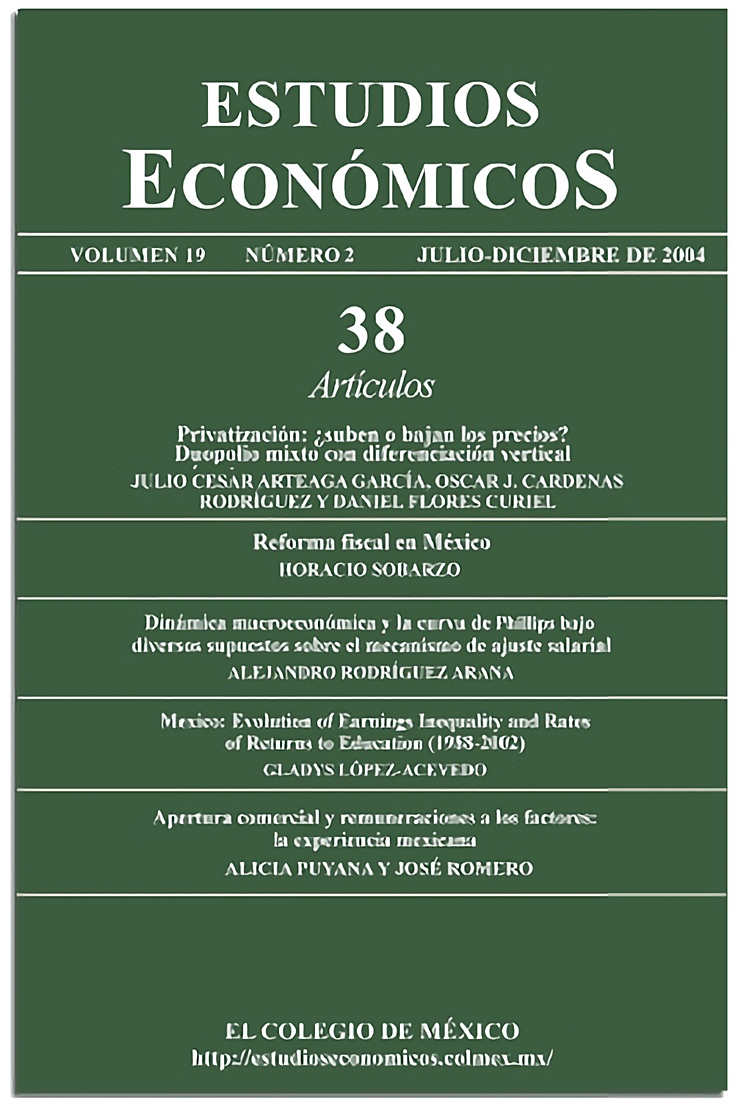Dinámica macroeconómica y la curva de Phillips bajo diversos supuestos sobre el mecanismo de ajuste salarial
Publicado 2004-07-01
Palabras clave
- macroeconomía,
- salarios nominales,
- inestabilidad dinámica
Cómo citar
Resumen
En un contexto macroeconómico simple, cuando los salarios nominales se fijan mediante una regla de indexación basada totalmente en variables del pasado, un choque en alguna variable nominal o real propicia que el producto y la inflación comiencen a oscilar, a veces en forma estable y otras de forma explosiva. Si las oscilaciones son estables, en muchos casos aparece una dinámica peculiar, probablemente compleja, en donde el producto y la inflación observan ciclos de orden múltiple, los cuales, a pesar de todo, muestran patrones definidos. El modelo de este trabajo sugiere que, en contextos más realistas, cambios marginales en ciertas reglas de ajuste de precios podrían generar hipersensibilidad de las variables macroeconómicas a los parámetros, así como inestabilidad dinámica.
Descargas
Citas
- Akerlof, G., W. Dickens y G. Perry (2000). “Near Rational Wage and Price Setting and the Long Run Phillips Curve”, Brookings Papers on Economic Activity, 1, pp. 1-44.
- Akerlof, G., W. Dickens y G. Perry (1996). “The Macroeconomics of Low Inflation”, Brookings Papers on Economic Activity, 1, pp. 1-59.
- Bean, C. (1983). “Targeting Nominal Income: an Appraisal”, Economic Journal, 93, pp. 806-819.
- Benassy, J. P. (2002). “Optimal Monetary and Fiscal Policy Under Wage and Price Rigidities”, Macroeconomic Dynamics, 6, pp. 429-441.
- Blanchard, O. (1990). “Why Does Money Affects Output?”, en B. Friedman y F. Hahn (comps.), Handbook of Monetary Economics, vol. 2, North Holland, Amsterdam.
- Blanchard, O. y S. Fisher (1989). Lectures on Macroeconomics, The MIT Press, Cambridge, Mass.
- Blanchard, O. y D. Pérez Enrri (2000). Macroeconomía: teoría y política económica con aplicaciones a América Latina, Prentice Hall.
- Blanchflower, D. y A. Oswald (1994). The wage curve, The MIT Press, Cambridge, Mass.
- Brainard, W. y G. Perry (2000), “Making Policy in a Changing World”, en W. Brainard y G. Perry (comps.), Economic Events, Ideas and Policies: The 1960´s and After, Brookings Institution.
- Calvo, G. y C. Végh (1994). “Stabilization Dynamics and Backward Looking Contracts”, Journal of Development Economics, 43, pp. 59-84.
- Chiang, A. (1984). Fundamental Methods of Mathematical Economics, 3a. ed., International Student Edition, McGraw Hill.
- Crowley, J. (1997). The Effects of Forward versus Backward Looking Wage Indexation on Price Stabilization Programmes, IMF Working Paper Series WP/97/38, IMF.
- Desai, M. (1973), “Growth Cycle and Inflation in a Model of Class Struggle”, Journal of Economic Theory, 6, pp. 527-545.
- Fair, R. C. (2000). “Testing the NAIRU Model for the United States”, The Review of Economics and Statistics, 82, pp. 64-71.
- Fischer, S. (1977). “Long Term Contracts, Rational Expectations and the Optimal Money Supply Rule”, reimpreso en R. Lucas y T. Sargent (comps.) Rational Expectations and Econometric Practice, vol. 1, 1981, University of Minessota Press, pp. 261-275.
- Friedman, M. (1968). “The Role of Monetary Policy”, American Economic Review, 58, pp. 1-17.
- Gali, J. (2000). “The Return of the Phillips Curve and Other Recent Developments in Business Cycle Theory”, Spanish Economic Review, 2, pp. 1-10.
- Gali, J. y D. López Salido (2001). “Una nueva curva de Phillips para España”, Moneda y Crédito, pp. 265-304.
- Chezzi, P. (2001). “Backward-Looking Indexation, Credibility and Inflation Persistence”, Journal of International Economics, 53, pp. 127-147.
- Gonzaga, G. y J. Scandiuzzi (1998). “How Does Government Wage Policy Affect Wage Bargaining in Brazil?”, Revista de Econometría, 18, pp. 1-30.
- Gordon, R. (1972). “Wage Price Controls and the Shifting Phillips Curve”, Brookings Papers on Economic Activity, 2, pp. 385-421.
- Gray, J. (1976). “Wage Indexation: A Macroeconomic Approach”, Journal of Monetary Economics, 2, pp. 221-235.
- Jadresic, E. (2001). “Wage Indexation and Output Stability Revisited”, Journal of Money, Credit and Banking, 34, pp. 178-196.
- Jadresic, E. (1997). What Kind of Contracts Underlie Aggregate Wage Dynamics? IMF Working Paper Series, WP/97/67, IMF.
- King, R. (2000). “The New IS-LM Model: Language, Logic and Limits”, Economic Quarterly, vol. 86, núm. 3, pp. 45-103.
- Lakshmikantham, V. y D. Trigiante (1988). “Theory of Difference Equations: Numerical Methods and Applications”, Mathematics in Science and Enginering, vol. 181.
- Modigliani, F. y T. Padoa-Shioppa (1978). The Economy with 100% plus Wage Indexation, MIT, (mimeo).
- Phelps, E. (1970). “Money Wage Dynamics and Labour Market Equilibrium”, en E. S. Phelps (comp.), Microeconomic Foundations of Employment and Inflation Theory, Norton, Nueva York.
- Phelps, E. (1967). “Phillips Curves, Expectations of Inflation and Optimal Unemployment Over Time”, Economica, 34, pp. 254-281.
- Poole, W. (1970). “Optimal Choice of Monetary Policy Instruments in a Simple Sthocastic Macro Model”, Quarterly Journal of Economics, 84, pp. 197-216.
- Roberts, J. (1997). The Wage Curve and the Phillips Curve, Finance and Economics Discussion Paper Series, 1997/57, Board of Governors of the Federal Reserve System.
- Romer, D. (1996). Advanced Macroeconomics, McGraw Hill.
- Rowthorn, R. E. (1977). “Conflict, Inflation and Money”, Cambridge Journal of Economics, 1, pp. 215-239.
- Taylor, J. (1980). “Aggregate Dynamics and Staggered Contracts”, Journal of Political Economy, 1, pp. 1-23.
- Taylor, J. (1979). “Staggered Wage Setting in a Macro Model”, American Economic Review, 69, pp. 108-113.
- Taylor, L. (1991). Income Distribution, Inflation and Growth, The MIT Press, Cambridge, Mass.
- Tobin, J. (1972). “The Wage Price Mechanism: Overview of the Conference”, en O. Ekstein (comp.), The Econometrics of Price Determination, Board of Governors of the Federal Reserve Bank.
- Trump, M. (1998). What is Chaos?, Ilya Prigogine Center for Studies in Statistical Mechanics and Complex Systems, Universidad de Texas en Austin, http://order.ph.utexas.edu/chaos/

